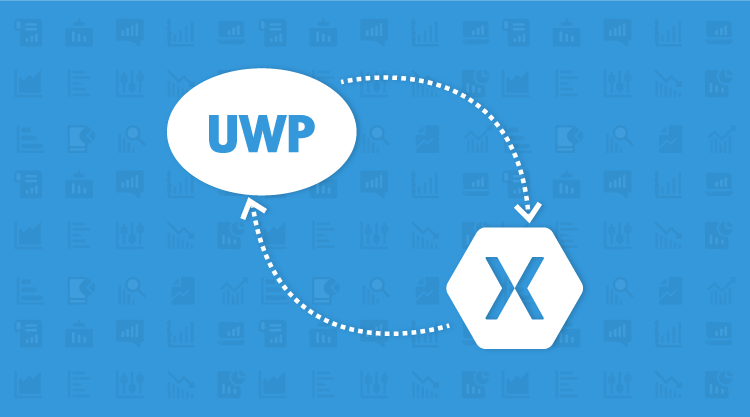Today we’re pleased to announce that the Visual Studio Dev Essentials program benefits now include free access to over 80 components and frameworks from Syncfusion’s component suite for building Xamarin and UWP applications.
All the available components are feature-rich and easy to use. There is also extensive documentation available to help integrate the components into your application within a few minutes. To demonstrate this, let us walk through the process of including charts and Excel reporting in an existing Xamarin application.
Adding charting capabilities
Step 1 : Install the required Chart NuGet packages as demonstrated here .
Step 2: Define a data model that represents a data point in SfChart.
public class Model { public string Name { get; set; } public double Height { get; set; } }
public class ViewModel { public List<Model> Data { get; set; } public ViewModel() { Data = new List<Model>() { new Model { Name = "David", Height = 180 }, new Model { Name = "Michael", Height = 170 }, new Model { Name = "Steve", Height = 160 }, new Model { Name = "Joel", Height = 182 } }; } }
<?xml version="1.0" encoding="utf-8" ?> <ContentPage >="http://xamarin.com/schemas/2014/forms" >="http://schemas.microsoft.com/winfx/2009/xaml" x:Class="ChartDemo.MainPage" >="clr-namespace:Syncfusion.SfChart.XForms;assembly=Syncfusion.SfChart.XForms" >="clr-namespace: ChartDemo"> <ContentPage.BindingContext> <local:ViewModel></local:ViewModel> </ContentPage.BindingContext> </ContentPage>
<?xml version="1.0" encoding="utf-8" ?> <ContentPage >="http://xamarin.com/schemas/2014/forms" >="http://schemas.microsoft.com/winfx/2009/xaml" x:Class="ChartDemo.MainPage" >="clr-namespace:Syncfusion.SfChart.XForms;assembly=Syncfusion.SfChart.XForms" >="clr-namespace: ChartDemo"> <ContentPage.BindingContext> <local:ViewModel></local:ViewModel> </ContentPage.BindingContext> <chart:SfChart> <chart:SfChart.PrimaryAxis> <chart:CategoryAxis></chart:CategoryAxis> </chart:SfChart.PrimaryAxis> <chart:SfChart.SecondaryAxis> <chart:NumericalAxis> <chart:NumericalAxis.Title> <chart:ChartAxisTitle Text="Height (in cm)"></chart:ChartAxisTitle> </chart:NumericalAxis.Title> </chart:NumericalAxis> </chart:SfChart.SecondaryAxis> <chart:SfChart.Series> <chart:ColumnSeries ItemsSource="{Binding Data}" XBindingPath="Name" YBindingPath="Height"></chart:ColumnSeries> </chart:SfChart.Series> </chart:SfChart> </ContentPage>
SfChart chart = new SfChart { PrimaryAxis = new CategoryAxis(), SecondaryAxis = new NumericalAxis() }; chart.SecondaryAxis.Title = new ChartAxisTitle { Text = "Height (in cm)" }; ColumnSeries columneSeries = new ColumnSeries(); columneSeries.ItemsSource = new List<Model>() { new Model { Name = "David", Height = 180 }, new Model { Name = "Michael", Height = 170 }, new Model { Name = "Steve", Height = 160 }, new Model { Name = "Joel", Height = 182 } }; columneSeries.XBindingPath = "Name"; columneSeries.YBindingPath = "Height"; chart.Series.Add(columneSeries);
Adding Excel reporting capabilities
Step 1 : Install the required XlsIO NuGet packages as demonstrated here .
Step 2: Read and write Excel files as shown in the following sample.
//Create an instance of ExcelEngine. using (ExcelEngine excelEngine = new ExcelEngine()) { //Set the default application version as Excel 2013. excelEngine.Excel.DefaultVersion = ExcelVersion.Excel2013; //Open an existing workbook. IWorkbook workbook = excelEngine.Excel.Workbooks.Open(inputExcelStream); //Access first worksheet from the workbook instance. IWorksheet worksheet = workbook.Worksheets[0]; //Set the text value to the cell worksheet["N1"].Text = "Total"; worksheet["A6"].Text = "Average"; //Set the formulas to the cell or range of cells worksheet["N2:N5"].FormulaR1C1 = "SUM(RC[-12]:RC[-1])"; worksheet["B6:M6"].FormulaR1C1 = "AVERAGE(R[-4]C:R[-1]C)"; worksheet["N6"].Formula = "SUM(B2:M5)"; //Set the column width in points. worksheet["A1:N1"].ColumnWidth = 10; //Save the workbook to stream in xlsx format. workbook.SaveAs(outputExcelStream); }






